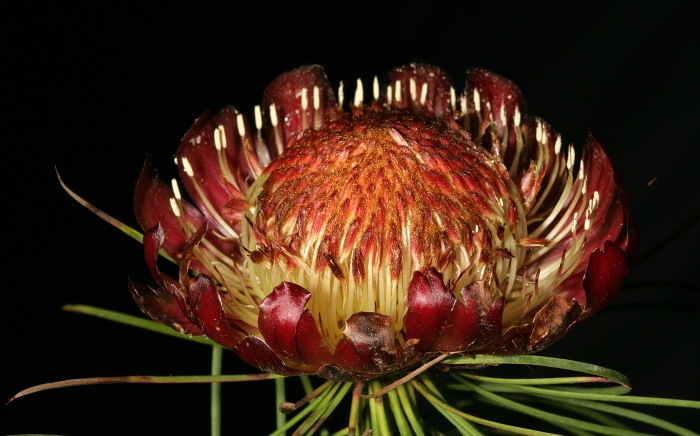Ceres Sugarbush
(Protea pityphylla)
Ceres Sugarbush (Protea pityphylla)
/
/

SAplants
CC BY-SA 4.0
Image By:
SAplants
Recorded By:
Copyright:
CC BY-SA 4.0
Copyright Notice:
Photo by: SAplants | License Type: CC BY-SA 4.0 | License URL: https://creativecommons.org/licenses/by-sa/4.0 | Uploader: SAplants | Publisher: Wikimedia Commons | Title: Protea_pityphylla_1DS-II_3-5561.jpg | Notes: ''Prunus andersonii'' * From: USDA-NRCS PLANTS Database [http://plants.usda.gov/java/profile?symbol=PRAN2&photoID=pran2_011_ahp.jpg] * Courtesy of USDI BLM. Mono Co., CA. July 2003. * Image without copyright, according to the above USDA page {{PD}} [[ |








Estimated Native Range
Summary
Protea pityphylla, commonly known as Ceres Sugarbush, is an evergreen shrub native to the fynbos region of Southwestern South Africa. This species is adapted to a Mediterranean climate with wet winters and dry summers, typically found in mountainous areas with acidic, nutrient-poor soils. It can grow up to 1 meter (3.3 ft) in height and may have somewhat erect or sprawling branches with glabrous (smooth and hairless) stems. The Ceres Sugarbush starts flowering around five years of age, producing inflorescences that are notable for their striking appearance, with flowers that are usually pink, red, or orange and surrounded by colorful bracts.
The Ceres Sugarbush is valued for its unique and attractive flowers, which make it a desirable plant for ornamental use in gardens that can mimic its native soil and climate conditions. It is often used in rockeries, native plant gardens, and as a feature plant in Mediterranean-style landscapes. This shrub requires well-drained, acidic soil and is drought-tolerant once established, making it suitable for low-water gardens. It thrives in full sun and can tolerate coastal conditions. Gardeners should be aware that Protea species can be sensitive to phosphorus, so fertilizers for these plants should have low phosphorus content.CC BY-SA 4.0
The Ceres Sugarbush is valued for its unique and attractive flowers, which make it a desirable plant for ornamental use in gardens that can mimic its native soil and climate conditions. It is often used in rockeries, native plant gardens, and as a feature plant in Mediterranean-style landscapes. This shrub requires well-drained, acidic soil and is drought-tolerant once established, making it suitable for low-water gardens. It thrives in full sun and can tolerate coastal conditions. Gardeners should be aware that Protea species can be sensitive to phosphorus, so fertilizers for these plants should have low phosphorus content.CC BY-SA 4.0
Plant Description
- Plant Type: Shrub
- Height: 1-4 feet
- Width: 1-3 feet
- Growth Rate: Moderate
- Flower Color: Red, Orange
- Flowering Season: Spring
- Leaf Retention: Evergreen
Growth Requirements
- Sun: Full Sun
- Water: Low, Medium
- Drainage: Medium, Fast
Common Uses
Bee Garden, Bird Garden, Butterfly Garden, Hummingbird Garden
Natural Habitat
Native to the fynbos region of Southwestern South Africa, adapted to a Mediterranean climate with wet winters and dry summers, typically found in mountainous areas with acidic, nutrient-poor soils
Other Names
Common Names: Mountain Rose
Scientific Names: , Protea pityphylla, Protea pityphylla var. latifolia,
GBIF Accepted Name: Protea pityphylla Phillips